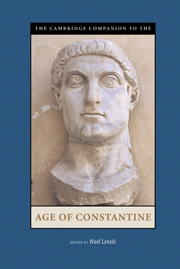Book contents
- Frontmatter
- Introduction
- 1 Sources for the History of Constantine
- Section 1 Politics and Personalities
- Section II Religion and Spiritual Life
- Section III Law and Society
- Section IV Art and Culture
- 11 Perspectives in Art
- 12 Architecture of Empire
- 13 Constantine in Legendary Literature
- Section V Empire and Beyond
- Appendix 1: Stemmata
- Appendix 2: Timeline
- Maps
- Primary Sources and Translations
- Secondary Bibliography
- Index
13 - Constantine in Legendary Literature
from Section IV - Art and Culture
Published online by Cambridge University Press: 28 September 2007
- Frontmatter
- Introduction
- 1 Sources for the History of Constantine
- Section 1 Politics and Personalities
- Section II Religion and Spiritual Life
- Section III Law and Society
- Section IV Art and Culture
- 11 Perspectives in Art
- 12 Architecture of Empire
- 13 Constantine in Legendary Literature
- Section V Empire and Beyond
- Appendix 1: Stemmata
- Appendix 2: Timeline
- Maps
- Primary Sources and Translations
- Secondary Bibliography
- Index
Summary
“Constantine sitting amongst the Christian bishops at the oecumenical council of Nicaea is in his own person the beginning of Europe’s Middle Age.” This oft-quoted sentence with which Norman Baynes concludes his chapter on Constantine in the first edition of the Cambridge Ancient History looks forward to the legacy of Constantine as founder of a Christian Byzantium and the Christian Roman empire of Pippin and Charlemagne in the medieval west. However, it was not Constantine the founder of “Caesaropapism” whom the historians and hagiographers of the Middle Ages - both east and west - chose to commemorate. His legacy in the Middle Ages, and in the west in particular, was partially obscured by those of two other figures of his reign who were the more popular as saints for veneration, pope Sylvester, who occupied the see of St. Peter for much of his reign, and Constantine’s mother, Helena Augusta.
The Sylvester Legend and the Baptism of Constantine
According to the Liberian Catalogue, Sylvester (feast, December 31) succeeded Miltiades as bishop of Rome on January 31, 314. At the time of Sylvester’s death, which occurred, according to the Depositio episcoporum, on December 31, 335, Constantine had transformed the relationship between the Roman state and Christian Church. He had personally heard the appeals from both sides of the Donatist dispute and had summoned the first ecumenical council to Nicaea in May 325 without the authority of Sylvester.
- Type
- Chapter
- Information
- The Cambridge Companion to the Age of Constantine , pp. 298 - 322Publisher: Cambridge University PressPrint publication year: 2005
- 2
- Cited by



